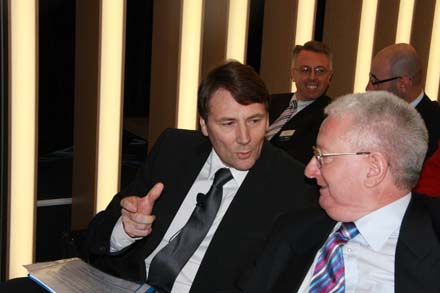Thodey defends $200m IT blowout

Telstra chief executive David Thodey today defended the progress of his company's five-year IT billing and customer relation management system modernisation, which has run $200 million over budget.

David Thodey talking to Telstra CFO John Stanhope today
(Credit: Liam Tung/ZDNet.com.au)
"I've been involved in too many IT transformations. There's nothing easy in here," Thodey told media and analysts at Telstra's annual results session. "It's easy to talk about, but harder to do. I do not know a better IT transformation ... We're within $200 million of the IT transformation."
Chief financial officer John Stanhope said the $200 million was around 2 per cent more than initially budgeted, and later noted that despite rumours that Telstra faced cost overruns, the increased bill was in part due to changing the scope of the project.
"There's lots of rumours about cost overrun," Stanhope responded to an analyst. "In October [Telstra's annual investor briefing] I will take you through the details. There are things about this program that weren't in there, such as BigPond. Now it is. That puts in more money."
Stanhope did, however, concede there was "a bit more complexity". "We did spend some more money as we came through to the realisation," he said.
Thodey said Telstra had moved 9.2 million of its customers to its new Siebel CRM system, but multi-product customers have yet to be migrated, while Telstra still faces the task of switching off legacy systems.
"As of last weekend, we had 9.2 million customers across the new platform. 17.8 million of our services are moved from the old platform to the new," said Thodey at his first annual earnings announcement as Telstra's chief executive.
A major milestone for Telstra remains switching off its legacy systems, which Thodey pointed out was where its sunk capital still lay. "We've done a tremendous amount in the IT arena, and we still have some legacy products to exist to move forward," he said.
In September last year Telstra announced it had completed the integration of BigPond as part of its transformation, which enabled it to shed 800 staff from the division as BigPond's access business was integrated with the rest of Telstra.
Telstra in 2005 had set a target of reducing its headcount by 10,000 to 12,000 as a result of its systems upgrade. Thodey would not update guidance on headcount it expected to shed, but he set expectations by relaying his experience when Telstra installed Siebel CRM in its Enterprise and Government division.
"In 2002 we put in Seibel [in Telstra Enterprise & Government]. I remember what happened. We put it in and the first release was an absolute failure. It took 15 months of working every application, trying to get the processes right. On some we got instantaneous benefits. Some took longer. Siebel is a wonderful product, but it takes some time to drive value from," he said.
"I don't think there is any necessity for any recourse to anyone because we're going to drive the value from the product. When people say you just drop a new CRM in get instantaneous value, well, it's just not true," he said.
Telstra's chief information officer, John McInerney, who took the role in 2008, clarified that several systems had been installed: Siebel/Oracle for Telstra's CRM, Kenan for its billing systems and Amdox for its order provisioning.
"So there are a lot of systems in this, and many are different stages of migration. All these systems are in production. So what we're doing is the migration of the customers across our release four platforms," said McInerney.